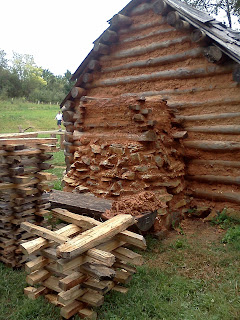From Julie H., historical interpreter:
We are working on daubing the chimney at our Settlement cabin. Yesterday, we had hoped to finish it, but the thunderstorms had other ideas!
Last time we talked about the chimney, we showed you the stacking process. You saw the chimney dry stacked to the width and height we wanted. We wondered the best way to daub the chimney up next. After some deliberation, and some good advice, we unstacked the chimney, intending to build it up again and daub it as we go.
We just received a large iron pole from our blacksmith, which we had to set in to the chimney, so earlier that week, we drilled some holes in the bottom two wooden beams. Once we unstacked, we used the opportunity to carefully chip away some mud, lift up the levels above the bottom beams, and shove the iron lug pole tightly in to place. It was easy enough to patch it up with more mud when we finished.
So that brings us to the actual daubing. Before we continue to build up, we need to go inside the chimney and patch up some of the older daubing over the wood. It is crucial that the wood be well covered with mud, because any exposed wood is possible to catch a stray spark from the flame. While we accept that our chimney probably will catch fire one day in the future (as did our ancestors), we don't want to tempt fate by doing a poor job daubing the inside and encourage it to burn down next month instead of years ahead.
Chimney daubing, much like daubing the gables on the cabin, require at least three people. We need one person to climb up the chimney to place the wood and to do the daubing, one person to hand them up mud, sticks, and wood, and one person to be making mud back in the pit. Just like the cabin, we need to place sticks in between the wooden frame of the chimney, in order to give the mud some structural support behind it. We thought about stacking up a couple layers, daubing them, and building up in that manner, but since we have to reach inside and down the chimney, we found it best to work a single layer at a time.
Most of this effort is me waiting for instructions from Andy on what he needs next. "Back beam!" "Front beam!" "Sticks!" "Mud!" "Chunky mud!" "Inside beam-- no,
inside beam." "Runny Mud!" "Okay, more sticks!"
Surprisingly, daubing the chimney is a lot messier than daubing the house. The chimney is an awkward shape, and difficult to put a ladder to sit stably next to it. So we have to climb the chimney. This means our shirts and shifts and knees are leaning up against fresh wet mud. We get caked in mud. It probably didn't help that the weather was wet and drizzly the entire day, so the stuff could never dry on our skins to crumble off. Did you notice we all stripped down to our historic underwear again?
Drew admires all the mud he's made for the chimney.
Below we have the progress of the chimney at the end of the first day of daubing.
We got pretty far. This was the only full day of daubing we've had thus far, so we were able to get a lot done! There aren't many days the three of us are there at the same time, and ever since that day, we've been plagued with afternoon thunderstorms that cut our efforts short. Yesterday, we managed to squeeze in about two hours of work in the morning before clear skies changed and slammed us with heavy rain and thunder.
Now that the chimney is built up taller, we can actually use the ladder. It and Andy are both light enough, and the chimney is strong enough, that we were able to lean the ladder up against it. This will make it easier for him to daub the top sections of the chimney.
This is where we left off. We have nine rows remaining. Our next issue is figuring out how to get mud up to him when he steps up another rung. I'm standing on tip-toes and stretching as far as I can as is (and still standing on that bench), and can barely reach him. I will probably have to climb part of the chimney next time to get mud up to Andy, which means Drew will have to hand me the mud off the tray so I'm not climbing up and down constantly.
We will hopefully have some time this week with the three of us and NO RAIN so we can finish this chimney! It was 52 degrees F this morning when I woke up, and only going to get colder. I can't start fires in an unfinished chimney!
Of course, a nice warm fire on a cool morning is somewhat useless until we make a front door to keep in the heat. Next time you hear from us folks on the Settlement farm, we should have a finished chimney, and the beginnings of a door. Fingers crossed!





































